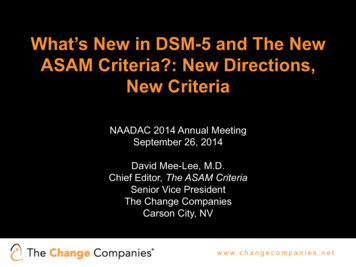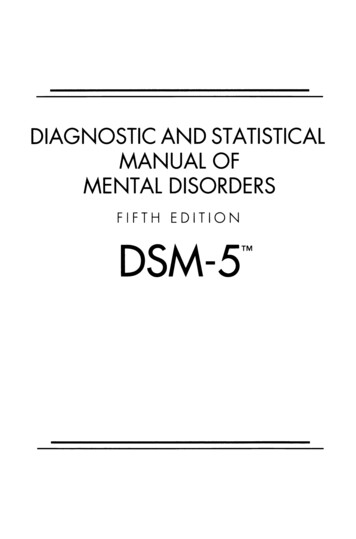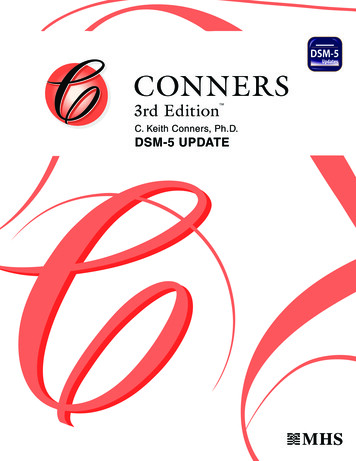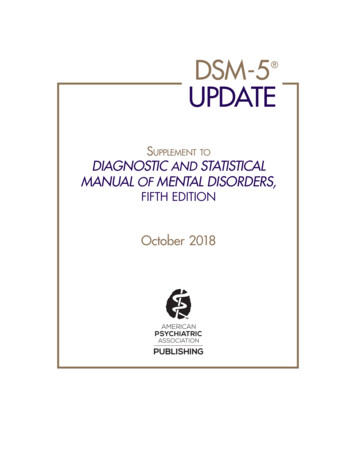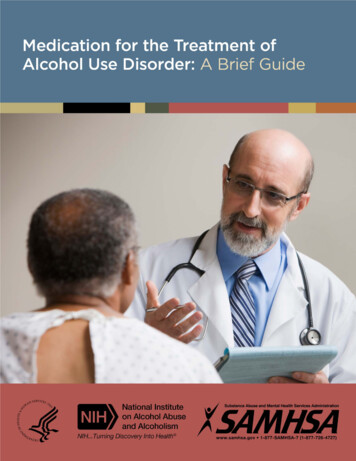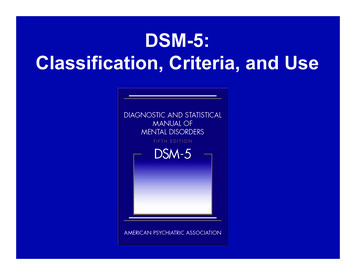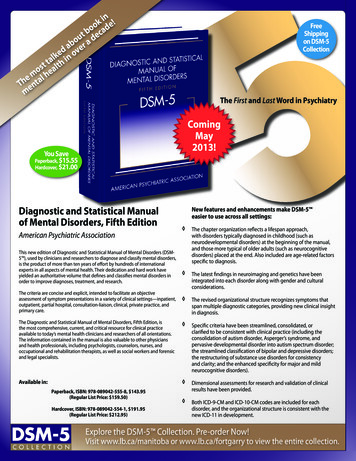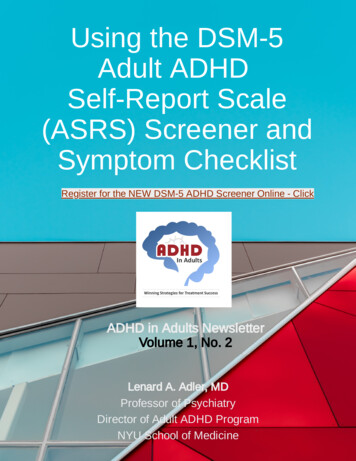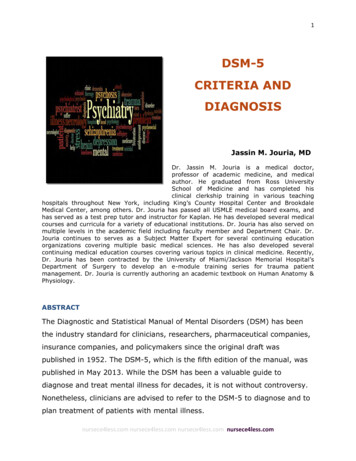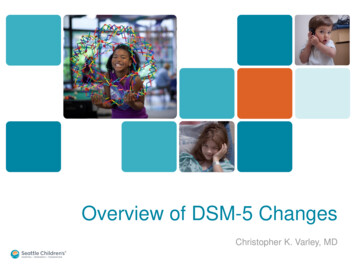
Transcription
Overview of DSM-5 ChangesChristopher K. Varley, MD
Disclosure to AudienceNo one involved in the planning or presentation of this activity has any relevant financial relationshipswith a commercial interest to discloseThe following are North Star Behavioral Health’s Content Controllers:Christopher K. Varley, MD - PresenterDr. Andy Mayo, CEODr. Ruth Dukoff, System Medical DirectorLaura McKenzie, QIRM DirectorDenise Gleason, CME CoordinatorEvelyn Alsup, Education Resource ManagerMedical Staff:Dr. Phillip NeubergerDr. Arom EvansDr. Manuel RodriguezDr. Elizabeth BaisiDr. David HjellenDr. Judith BautistaDr. Jill AbramEducation Committee:Sabrina Ben, HRDCarla MacGregor, DRTC AdministratorRon Meier, PRTC Clinical DirectorMelanie Nelson, DOSSBrandy Proctor, DONSarah Skeel, PRTC AdministratorBusiness Development Department:Elke Villegas, Director of Business DevelopmentLindsey Fletcher, Clinical Community LiaisonBecky Bitzer, Clinical Community LiaisonAlice Walter, Clinical Community LiaisonSarah Twaddle, Clinical Community Liaison
DSM-5 Revisions DSM-IV’s organizational structure failed toreflect shared features or symptoms ofrelated disorders and diagnostic groups (likepsychotic disorders with bipolar disorders, orinternalizing (depressive, anxiety, somatic)and externalizing (impulse control, conduct,substance use) disorders. DSM-5 restructuring better reflects theseinterrelationships, within and acrossdiagnostic chapters
DSM-5 Revisions DSM-IV does not adequately address thelifespan perspective, including variations ofsymptom presentations across thedevelopmental trajectory, or cultural perspectives DSM-5’s chapter structure, criteria revisions, andtext outline actively address age anddevelopment as part of diagnosis andclassification Culture is similarly discussed more explicitly tobring greater attention to cultural variations insymptom presentations
DSM-5 Revisions DSM-5 represents an opportunity to betterintegrate neuroscience and the wealth offindings from neuroimaging, genetics,cognitive research, and the like, that haveemerged over the past several decades – allof which are vital to diagnosis and treatmentdevelopment DSM-5 will be more amenable to updates inpsychiatry and neuroscience, making it a“living document” and less susceptible tobecoming outdated than its predecessors
DSM-5 Revisions The multiaxial system in DSM-IV is not requiredto make a mental disorder diagnosis and has notbeen universally used DSM-5 has moved to a nonaxial documentationof diagnosis (formerly Axes I, II, and III), withseparate notations for important psychosocialand contextual factors (formerly Axis IV) anddisability (formerly Axis V) This approach is consistent with establishedWHO and ICD guidance to consider theindividual’s functional status separately from hisor her diagnoses or symptom status
Elimination of Multi-Axial Diagnosis Axis IV - psychosocial and environmental factors - arenow covered through an expanded set of V codes. Vcodes allow clinicians to indicate other conditions thatmay be a focus of clinical attention or affect diagnosis,course, prognosis or treatment of a mental disorder Axis V - CGAS and GAF - are replaced by separatemeasures of symptoms severity and disability forindividual disorders. An eventual change to the WorldHealth Organization Disability Assessment Schedule(WHO DAS 2.0) is anticipated for measurement ofdisability, however it is not yet recommended for use byAPA until it has been studied further.
Clustering of Chapters Neurodevelopmental DisordersEmotional (Internalizing) DisordersSomatic DisordersExternalizing DisordersNeurocognitive DisordersPersonality Disorders
DSM-5 ChaptersNeurodevelopmental DisordersSchizophrenia Spectrum and Other Psychotic DisordersBipolar and Related DisordersDepressive DisordersAnxiety DisordersObsessive-Compulsive and Related DisordersTrauma-and Stressor-Related DisordersDissociative DisordersSomatic Symptom DisordersFeeding and Eating Disorders
DSM-5 Chapters (continued)Elimination DisordersSleep-Wake DisordersSexual DysfunctionsGender DysphoriaDisruptive, Impulse Control and Conduct DisordersSubstance Use and Addictive DisordersNeurocognitive DisordersPersonality DisordersParaphilic DisordersOther Disorders
Changes in Terminology Not Otherwise Specified (NOS) has been used as a“catch-all” for patients who didn’t fit into the more specificcategories. NOS language is eliminated in DSM-5. There will now be an option for designating NotElsewhere Classified (NEC) which will typically include alist of specifiers as to why the patient’s clinical conditiondoesn’t meet a more specific disorder. The phrase “general medical condition” is replaced inDSM-5 with “another medical condition” where relevantacross all disorders. These classification changes will help providers with thetransition to ICD-10 in October 2014. DSM-5 includesthe ICD-10 diagnoses in parentheses.
Highlights: Neurodevelopmental DisordersIntellectual Disability(Intellectual Developmental Disorder) Diagnostic criteria for intellectual disability (intellectualdevelopmental disorder) emphasize the need for anassessment of both cognitive capacity (IQ) and adaptivefunctioning. Severity is determined by adaptivefunctioning rather than IQ score. Despite the name change, the deficits in cognitivecapacity beginning in the developmental period, with theaccompanying diagnostic criteria, are considered toconstitute a mental disorder. No longer use of term “mental retardation.”
Criteria: Neurodevelopmental DisordersIntellectual Disability (Intellectual DevelopmentalDisorder)A. Deficits in intellectual functions, such as reasoning, problem solving,planning, abstract thinking, judgment, academic learning, and learningfrom experience, confirmed by both clinical assessment andindividualized, standardized intelligence testing.B. Deficits in adaptive functioning that result in failure to meetdevelopmental and socio-cultural standards for personal independenceand social responsibility. Without ongoing support, the adaptive deficitslimit functioning in one or more activities of daily life, such ascommunication, social participation, and independent living, acrossmultiple environments, such as home, school, work, and community.C. Onset of intellectual and adaptive deficits during the developmentalperiod.Specify severity (based on adaptive function, not IQ): Mild, Moderate,Severe, Profound
Criteria: Neurodevelopmental DisordersGlobal Developmental DelayDiagnosed reserved for individuals under 5 when clinical severity levelcannot be reliably assessed. Diagnosed when an individual fails tomeet expected developmental milestones in several areas ofintellectual functioning, and applies to individuals who are unable toundergo systematic assessments of intellectual functioning, includingchildren who are too young to participate in standardized testing.Requires reassessment after a period of time.Unspecified Intellectual DisabilityDiagnosed in individuals over 5 when assessment of the degree ofintellectual disability by means of locally available procedures isdifficult or impossible because of associated sensory or physicalimpairments, as in blindness or prelingual deafness; locomotordisability; or presence of severe problem behaviors or co-occurringmental disorder. Should only be used in exceptional circumstancesand requires reassessment after a period of time.
Criteria: Neurodevelopmental DisordersCommunication DisordersThe DSM-5 communication disorders include new and revisedconditions: Language Disorder (which combines DSM-IV expressive and mixedreceptive-expressive language disorders) Speech Sound Disorder (a new name for phonological disorder) Childhood-Onset Fluency Disorder (a new name for stuttering) Social (pragmatic) Communication Disorder, a new condition forpersistent difficulties in the social uses of verbal and nonverbalcommunication (ASD is an obligate rule-out).
DSM-5:Autistic DisorderAsperger’s DisorderPDD-NOSAutism Spectrum DisorderCDD
3 become 2Impairment in Social InteractionDeficits in social communicationand social interactionQualitative impairment incommunicationRestricted repetitive andstereotyped patterns of behavior,interests, and activitiesRestricted, repetitive patterns ofbehavior, interests, or activities
A. Persistent deficits in social communication and social interactionacross multiple contexts, manifested by the following, currently or byhistory (examples are illustrative not exhaustive; see text):1.Deficits in social-emotional reciprocity; ranging, for example, fromabnormal social approach and failure of normal back-and-forth conversation;to reduced sharing of interests, emotions, or affect; to failure to initiate orrespond to social interactions.2. Deficits in nonverbal communicative behaviors used for socialinteraction, ranging, for example, from poorly integrated verbal andnonverbal communication; to abnormalities in eye contact and bodylanguage or deficits in understanding and use of gestures; to a total lack offacial expressions and nonverbal communication.3. Deficits in developing, maintaining, and understanding relationships,ranging, for example, from difficulties adjusting behavior to suit varioussocial contexts; to difficulties in sharing imaginative play or in makingfriends, to absence of interest in peers.
B. Restricted, repetitive patterns of behavior, interests, or activities, asmanifested by at least two of the following, currently or by history(examples are illustrative, not exhaustive; see text):1.Stereotyped or repetitive motor movements, use of objects, or speech(e.g., simple motor stereotypies, lining up toys or flipping objects, echolalia,idiosyncratic phrases).2.Insistence on sameness, inflexible adherence to routines, or ritualizedpatterns of verbal or nonverbal behavior (e.g., extreme distress at smallchanges, difficulties with transitions, rigid thinking patterns, greeting ritualsneed to take same route or eat same food every day).3.Highly restricted, fixated interests that are abnormal in intensity or focus(e.g., strong attachment to or preoccupation with unusual objects, excessivelycircumscribed or perseverative interests).4.Hyper- or hypo-reactivity to sensory input or unusual interest in sensoryaspects of the environment (e.g., apparent indifference to pain/temperature,adverse response to specific sounds or textures, excessive smelling ortouching of objects, visual fascination with lights or movement).
C. Symptoms must be present in the early developmentalperiod (but may not become fully manifest until socialdemands exceed limited capacities; or may be masked bylearned strategies in later life).D. Symptoms cause clinically significant impairment insocial, occupational, or other important areas of currentfunctioning.E. These disturbances are not better explained by intellectualdisability (intellectual developmental disorder) or globaldevelopmental delay. Intellectual disability and autism spectrumdisorder frequently co-occur; to make comorbid diagnoses ofautism spectrum disorder and intellectual disability, socialcommunication should be below that expected for generaldevelopmental level.
Note: Individuals with a well-establishedDSM-IV TR diagnosis of Autisticdisorder, Asperger’s disorder, orPervasive Developmental Disorder NotOtherwise Specified should be given thediagnosis of Autism Spectrum Disorder.
Autism Spectrum Disorder: Specifiers With/without accompanying intellectual impairment. With/without accompanying language impairment. Associated with a known medical or genetic condition orenvironmental factor. Associated with another neurodevelopmental, mental, orbehavioral disorder. With catatonia.Autism Spectrum Disorder: Severity Severity is based on social communication impairmentsand restricted, repetitive patterns of behavior (see Table2 in text).
SeverityLevelSocial CommunicationLevel 3Severe deficits in verbal and nonverbal social communication skillscause severe impairments in functioning; very limited initiation ofsocial interactions and minimal response to social overtures fromothers. E.g. someone with around 20 words of intelligible speech,rarely initiates interaction, and when does so makes unusualapproach to meet needs only, responds to only very direct socialapproach.Inflexibility of behavior, extreme difficultycoping with change, or otherrestricted/repetitive behaviors markedlyinterfere with functioning in all spheres.Great distress/difficulty changing focus oraction.Marked deficits in verbal and nonverbal social communicationskills; social impairments apparent even with supports in place;limited initiation of social interactions and reduced or abnormalresponse to social overtures from others. E.g., a person whospeaks simple sentences, interaction limited to narrow specialinterests, markedly odd nonverbal communication.Inflexibility of behavior, difficulty copingwith change, or other restricted/repetitivebehaviors appear frequently enough to beobvious to the casual observer andinterfere with functioning in a variety ofcontexts. Distress and/or difficulty changingfocus or action.Restricted, repetitive behaviors‘Requiring very substantial support’Level 2‘Requiring substantial support’Level 1Without supports in place, deficits in social communication causenoticeable impairments. Has difficulty initiating social interactionsand demonstrates clear examples of atypical or unsuccessfulresponses to social overtures of others. May appear to havedecreased interest in social interactions. E.g., a person able tospeak in full sentences, engages in communication but to-and-froof conversation fails, attempts to make friends are odd andtypically unsuccessful.‘Requiring support’Inflexibility of behavior causes significantinterference with functioning in one ormore contexts. Difficulty switching betweenactivities. Problems of organization andplanning hamper independence.
Highlights: Neurodevelopmental DisordersAttention Deficit/Hyperactivity Disorder Several changes in DSM-5:1) examples have been added to the criterion items to facilitate applicationacross the life span;2) the cross-situational requirement has been strengthened to “several”symptoms in each setting;3) the onset criterion has been changed from “symptoms that causedimpairment were present before age 7 years” to “several inattentive orhyperactive-impulsive symptoms were present prior to age 12”;4) subtypes have been replaced with presentation specifiers that mapdirectly to the prior subtypes;5) a comorbid diagnosis with autism spectrum disorder is now allowed;6) a symptom threshold change has been made for adults, with the cutoff offive symptoms, instead of six required for younger persons, both forinattention and for hyperactivity/impulsivity.ADHD now falls under the Neurodevelopmental Disorders Chapter
Highlights: Neurodevelopmental DisordersSpecific Learning Disorder Specific Learning Disorder combines the DSM-IV TRdiagnoses of reading disorder, mathematics disorder,disorder of written expression, and learning disorder nototherwise specified. Because learning deficits in the areas of reading, writtenexpression, and mathematics commonly occur together,coded specifiers for the deficit types in each area areincluded.
Highlights: Other NeurodevelopmentalDisordersDevelopmental Coordination DisorderStereotypic Movement DisorderTic DisordersTourette’s DisorderPersistent Motor or Vocal Tic DisorderProvisional Tic Disorder (1 year)Other Specified Neurodevelopmental Disordere.g. Neurodevelopmental disorder associated withprenatal alcohol exposure (section 3).Unspecified Neurodevelopmental Disorder
Highlights: Schizophrenia SpectrumDisorders Two Criterion A symptoms are now required for anydiagnosis of schizophrenia in DSM-5 (cf single bizarre). Also, the individual must have at least one of these three“positive” symptoms: delusions, hallucinations, anddisorganized speech. The DSM-IV TR subtypes of schizophrenia (i.e., paranoid,disorganized, catatonic, undifferentiated, and residualtypes) are eliminated due to their limited diagnostic stability,low reliability, and poor validity.
Highlights: Schizoaffective Disorder The primary change to schizoaffective disorder is therequirement that a major mood episode be present for amajority of the disorder’s total duration after Criterion A hasbeen met. This change makes schizoaffective disorder a longitudinalinstead of a cross-sectional diagnosis—more comparableto schizophrenia, bipolar disorder, and major depressivedisorder, which are bridged by this condition.
Highlights: Delusional Disorder Criterion A for delusional disorder no longer has therequirement that the delusions must be non-bizarre. A specifier for bizarre type delusions provides continuitywith DSM-IV TR. The demarcation of delusional disorder from psychoticvariants of obsessive-compulsive disorder and bodydysmorphic disorder is explicitly noted with a new exclusioncriterion, which states that the symptoms must not be betterexplained by conditions such as obsessive-compulsive orbody dysmorphic disorder with absent insight/delusionalbeliefs.
Highlights: Catatonia In DSM-5, all contexts require three catatonic symptoms(from a total of 12 characteristic symptoms). In DSM-5, catatonia may be diagnosed as a specifier fordepressive, bipolar, and psychotic disorders; as a separatediagnosis in the context of another medical condition; or asan other specified diagnosis.
Highlights: Bipolar and Related DisordersBipolar DisordersTo enhance the accuracy of diagnosis and facilitate earlierdetection in clinical settings, Criterion A for manic andhypomanic episodes now includes an emphasis on changesin activity and energy as well as mood.The DSM-IV TR diagnosis of Bipolar I Disorder, mixedepisode, requiring that the individual simultaneously meet fullcriteria for both mania and major depressive episode, hasbeen removed. Instead, a new specifier, “with mixedfeatures,” has been added that can be applied to episodes ofmania or hypomania when depressive features are present,and to episodes of depression in the context of majordepressive disorder or bipolar disorder when features ofmania/hypomania are present.
Highlights: Bipolar and Related DisordersOther Specified Bipolar and Related DisorderDSM-5 allows the specification of particular conditions forother specified bipolar and related disorder, includingcategorization for individuals with a past history of a majordepressive disorder who meet all criteria for hypomaniaexcept the duration criterion (i.e., at least 4 consecutivedays).A second condition constituting an other specified bipolarand related disorder is that too few symptoms of hypomaniaare present to meet criteria for the full bipolar II syndrome,although the duration is sufficient at 4 or more days.
Highlights: Anxious Distress SpecifierIn the chapter on bipolar and related disorders and thechapter on depressive disorders, a specifier for anxiousdistress is delineated. This specifier is intended to identifypatients with anxiety symptoms that are not part of thebipolar diagnostic criteria.
Highlights: Depressive Disorders To address concerns about potential over diagnosis andovertreatment of bipolar disorder in children, a newdiagnosis, Disruptive Mood Dysregulation Disorder, isincluded for children up to age 18 years who exhibitpersistent irritability and frequent episodes of extremebehavioral dyscontrol. What was referred to as Dysthymia in DSM-IV TR nowfalls under the category of Persistent DepressiveDisorder, which includes both chronic major depressivedisorder and the previous dysthymic disorder. Premenstrual Dysphoric Disorder is now a distinctdiagnosis in the Depressive Disorders chapter.
Criteria: New Disruptive Mood DysregulationDisorderA. Severe recurrent temper outbursts manifested verbally and/orbehaviorally that are grossly out of proportion in intensity or duration tothe situation or provocation.B. The temper outbursts are inconsistent with developmental level.C. The temper outbursts occur, on average, 3X per week.D. The mood between temper outbursts is persistently irritable or angrymost of the day, nearly every day, and as observable by others.E. Criteria A-D have been present for 12 mo. Throughout that time, theindividual has not had a period 3 consecutive months without all ofthe symptoms in A-D.F. Criteria A and D are present in at least two of three settings and aresevere in at least one of these.G. The diagnosis should not be made for the first time before age 6 orafter age 18.
Criteria: Disruptive Mood DysregulationDisorder (continued)H. By history or observation, the age at onset of Criteria A-E is before 10years.I. There has never been a distinct period lasting more than one day duringwhich the full symptom criteria, except duration, for a manic orhypomanic episode have been met.J. The behaviors do not occur exclusively during an episode of majordepressive disorder and are not better explained by another mentaldisorder.K. The symptoms are not attributable to the physiological effects of asubstance or to another medical or neurological condition.
Highlights: Bereavement exclusion forDepressionIn DSM-IV TR, there was an exclusion criterion for a major depressiveepisode that was applied to depressive symptoms lasting less than 2months following the death of a loved one (i.e., the bereavementexclusion). This exclusion is omitted in DSM-5 to remove the implicationthat bereavement typically lasts only 2 months when clinicians recognizethat the duration is more commonly 1–2 years.Bereavement is recognized as a severe psychosocial stressor that canprecipitate a major depressive episode in a vulnerable individual,generally beginning soon after the loss. Bereavement-related majordepression is genetically influenced and is associated with similarpersonality characteristics, patterns of comorbidity, and risks of chronicityand/or recurrence as non–bereavement-related major depressiveepisodes.The depressive symptoms associated with bereavement-relateddepression respond to the same psychosocial and medication treatmentsas non–bereavement-related depression.
Highlights: Anxiety Disorders Panic Disorder and Agoraphobia are now unlinked inDSM-5 as many patients experience Agoraphobiawithout panic symptoms For Agoraphobia, Specific Phobia, and Social AnxietyDisorder (Social Phobia): the 6 month duration criterion has been extended to all ages(formerly just individuals under age 18) to minimize overdiagnosis of transient fears. The anxiety must be out of proportion to the actual danger orthreat, but the requirement that individuals over age 18 yearsrecognize their anxiety as excessive or unreasonable has beeneliminated.
Highlights: Anxiety Disorders (continued) Panic attack descriptors have changed to identify“unexpected and expected” panic attacks. Panic attacksfunction as a prognostic factor for severity of diagnosis,course, and comorbidity across many anxiety and otherdisorders, and thus can be listed as a specifier that isapplicable to all DSM-5 disorders. Separation Anxiety Disorder and Selective Mutism nowfall under the Anxiety Disorders chapter instead of theDisorders of Infancy, Childhood or Adolescence (thischapter has been eliminated). Age criteria for Separation Anxiety Disorder have beenchanged to allow onset after age 18, with a durationcriterion added of “typically lasting 6 months or more”.
Highlights: Obsessive-Compulsive andRelated Disorders A new chapter has been developed to includeObsessive-Compulsive Disorder along with four newdisorders: Hoarding Disorder Excoriation Disorder (skin picking) Substance-medication induced obsessive-compulsive andrelated disorder Obsessive-compulsive and related disorder due to anothermedical condition Body Dysmorphic Disorder and Trichotillomania now fallunder Obsessive-Compulsive and Related Disorders Insight specifiers have been refined to distinguishbetween levels of insight of patients with thesedisorders.
Highlights: Trauma- and Stressor- RelatedDisorders A new chapter called Trauma- and Stressor- RelatedDisorders has been made which includes: Reactive Attachment Disorder (emotionally withdrawn/inhibited) New diagnosis of Disinhibited Social Engagement Disorder(formerly the indiscriminately social/disinhibited version ofReactive Attachment Disorder) Posttraumatic Stress Disorder and Acute Stress Disorder(moved from the Anxiety Disorders Chapter) Adjustment Disorders (formerly in a separate chapter) Acute Stress Disorder has a change in stressor criterionbeing explicit as to whether the traumatic event wasexperienced directly or indirectly, or witnessed
Highlights: Trauma- and Stressor- RelatedDisorders (continued) Posttraumatic Stress Disorder has also had changes inthe stressor criterion being explicit as to whether thetraumatic event was experienced directly or indirectly, orwitnessed The criterion for subjective reaction is eliminated. There are now four symptom clusters instead of threebecause avoidance/numbing is divided into two clusters:avoidance and persistent negative emotional states. Arousal/reactivity cluster includes irritable or aggressivebehavior and reckless/self-destructive behavior. Diagnostic thresholds lowered for children/adolescentsand separate criteria for children ages 6 and younger.
Highlights: Somatic Symptom and RelatedDisorders DSM-5 has reduced the number of somatoformdisorders and subcategories to avoid problematicoverlap with medical conditions. Diagnoses of somatization disorder, hypochondriasis,pain disorder, and undifferentiated somatoform disorderhave been removed. Patients with high health anxiety without somaticsymptoms would receive a diagnosis of illness anxietydisorder (unless their anxiety symptoms are betterexplained by a primary anxiety disorder such as GAD). Patients formerly diagnosed with Pain Disorder maynow be diagnosed with Somatic Symptom Disorder withpredominant pain.
Highlights: Feeding and Eating Disorders Criteria for Pica and Rumination Disorder have beenrevised for clarity and to indicate that diagnoses can bemade for individuals of any age. The diagnosis “Feeding Disorder of Infancy or EarlyChildhood” has been renamed “Avoidant/RestrictiveFood Intake Disorder” and criteria have been expanded. The requirement of amenorrhea has been eliminatedfrom Anorexia Nervosa for several reasons (e.g. formales, females taking contraceptives) Binge Eating Disorder is a distinct diagnosis and bingeeating criteria is at least once weekly for 3 months whichis identical to criteria for Bulimia Nervosa.
Highlights: Disruptive, Impulse-Control andConduct Disorders This is a new chapter for DSM-5 bringing togetherdisorders that fell under two categories in DSM-IV(Disorders of Infancy, Childhood or Adolescence andImpulse-Control Disorders Not Otherwise Specified) These disorders are all characterized by problems inemotional and behavioral self-control. Because of the close association with Conduct Disorder,the diagnosis of Antisocial Personality Disorder now hasa dual listing in this chapter and the Personality Disorderchapter. ADHD is frequently co-morbid with disorders in thischapter but is listed with neurodevelopmental disorders
Highlights: Disruptive, Impulse-Control andConduct Disorders (continued) Four refinements are made for Oppositional DefiantDisorder criteria: Symptoms are grouped into three types: angry/irritable mood,argumentative/defiant behavior, and vindictiveness Exclusion criteria for conduct disorder have been removed Because many typically developing children and adolescentshave symptoms that fall under this diagnosis, a note has beenadded about frequency needed for a behavior to besymptomatic of the disorder Severity rating has been added reflecting pervasiveness as animportant indicator of severity A minimum age of 6 years has been set for IntermittentExplosive Disorder to distinguish from normal tantrums
Highlights: Substance-Related and AddictiveDisorders New diagnosis of Gambling Disorder has been added,reflecting research that some behaviors such asgambling activate the brain reward system similar todrugs of abuse. Substance Abuse Disorders will no longer separate out“abuse” versus “dependence” as these disorders occuron a continuum. The categories are described as“substance use disorders” with criteria for intoxication,withdrawal, substance/medication-induced disorders,and unspecified substance-induced disorders. New criterion of craving or strong desire or urge to use. Recurrent legal problems criterion has been deleted.
DSM-5 to ICD-9 Crosswalkfor Psychiatric Disorders This crosswalk is designed to help providers match theDSM-5 and ICD-9 diagnosis codes which are usedcurrently in billing. Under the Health InsurancePortability and Accessibility Act (HIPPA), insurancecompanies are only required to accept ICD-9 diagnosis.The descriptions in ICD 9 do not always match directlyto descriptions in DSM 5, so options are provided belowunder ICD 9 Diagnosis Description to help providerschoose the best match. Disorders chapters that not included in this crosswalkinclude Sleep-Wake Disorders, Sexual Dysfunction,Neurocognitive Disorders, Personality Disorders,Paraphilic Disorders, and Other Mental Disorders.
DSM-5 to ICD-9 Crosswalkfor Psychiatric Disorders This crosswalk is designed to help providers match theDSM-5 and ICD-9 diagnosis codes which are usedcurrently in billing. Under the Health InsurancePortability and Accessibility Act (HIPPA), insurancecompanies are only required to accept ICD-9 diagnosis.The descriptions in ICD 9 do not always match directlyto descriptions in DSM 5, so options are provided belowunder ICD 9 Diagnosis Description to help providerschoose the best match. Disorders chapter
DSM-5 Revisions DSM-5 represents an opportunity to better integrate neuroscience and the wealth of findings from neuroimaging, genetics, cognitive research, and the like, that have emerged over the past several decades – all of which are vital to diagnosis and treatment development DSM
